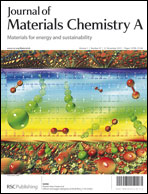A general approach for producing nanoporous carbon, especially as evidenced for the case of adipic acid and zinc†
Abstract
In this work, we demonstrate a novel and general synthetic approach for producing nanoporous carbon materials, using adipic acid and zinc powder as raw materials. The mass ratio and carbonization temperature have crucial effects on the structure and electrochemical behavior of the carbon samples. The optimum sample is carbon-1:2-700; it is amorphous in nature and has a high BET surface area of 1426 m2 g−1 and a very large pore volume of 5.92 cm3 g−1. What's more, the sample takes on sheet-like structures entirely composed of nanopores. The electrochemical performance is measured in a three-electrode system using 6 mol L−1 KOH as the electrolyte, and a two-electrode system using [EMIm]BF4/AN as the electrolyte, respectively. In the three-electrode system, it delivers a high specific capacitance of 373.3 F g−1 at a current density of 2 A g−1. Furthermore, it displays a good cycling durability of 93.9% after 10 000 cycles. In the two-electrode system, the voltage window has been largely broadened and a series of temperature-dependent measurements are adopted. More importantly, the present synthetic method can be extended to other chemical substances as carbon precursors to produce porous carbon, which can greatly enrich the field of porous carbon synthesis as well as their application as supercapacitors.


 Please wait while we load your content...
Please wait while we load your content...